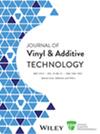One-step polymerization of polyvinyl alcohol/cashew gum/polypyrrole/copper oxide nanocomposites for high-performance flexible films in optoelectronics
Abstract
A ternary blend nanocomposite composed of polyvinyl alcohol/cashew gum/polypyrrole (PVA/CG/PPy) with varying contents of copper oxide (CuO) nanoparticles was synthesized via an in situ polymerization method, using water as an eco-friendly solvent. Fourier-transform infrared spectroscopy (FTIR), UV–visible spectroscopy, field emission scanning electron microscopy (FE-SEM), x-ray diffraction (XRD), thermogravimetric analysis (TGA), and differential scanning calorimetry (DSC) were used to characterize the ternary blend nanocomposites. FTIR and UV–visible spectra demonstrated strong intermolecular interactions between the functional groups of the PVA/CG/PPy blend and the CuO nanoparticles. XRD patterns revealed that the CuO nanofillers were arranged in a structured manner within the ternary blend matrix. FE-SEM confirmed the uniform dispersion and structured arrangement of CuO nanofillers at a concentration of 3 wt% within the blend matrix. TGA and DSC results showed that the addition of CuO nanoparticles to the PVA/CG/PPy blend improved both the thermal stability and glass transition temperature of the blend matrix. Electrical properties improved with CuO content up to 3 wt%, resulting in enhanced conductivity, an increased dielectric constant, and reduced activation energy. The highest tensile strength, 13.76 MPa, was also observed at this concentration. However, properties declined beyond 3 wt% due to agglomeration, making 3 wt% the ideal concentration for maximum performance. This study highlights the potential of PVA/CG/PPy/CuO nanocomposites for applications requiring improved electrical properties and thermal stability, particularly in flexible electronics and energy storage devices.
Highlights
- Eco-friendly synthesis of PVA/CG/PPy/CuO biopolymer nanocomposite films
- Improvement in morphological, and optical properties of PVA/CG/PPy/CuO films.
- CuO nanofillers magnify the thermal properties of the pristine PVA/CG/PPy
- Conductivity and dielectric characteristics: frequency and temperature dependence explored.
- PVA/CG/PPy/CuO nanocomposite films: pliable contenders unveiling industrial potentials.


 求助内容:
求助内容: 应助结果提醒方式:
应助结果提醒方式:


